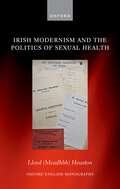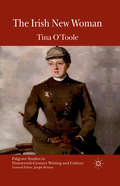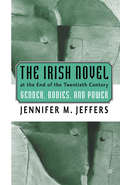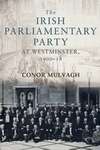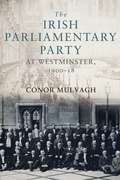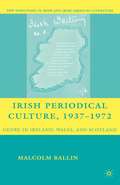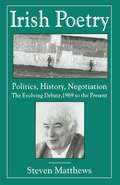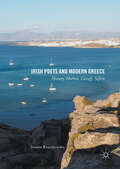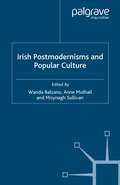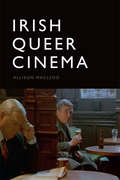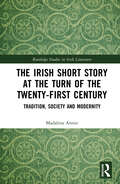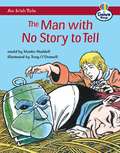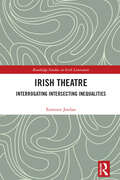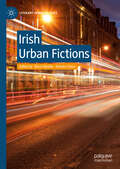- Table View
- List View
Irish Modernism and the Politics of Sexual Health (Oxford English Monographs)
by Lloyd (Meadhbh) HoustonIrish Modernism and the Politics of Sexual Health explores the politicized role of sexual health as a concept, discourse, and subject of debate within Irish literary culture from 1880 to 1960. Combining perspectives from Irish Studies, Modernist Studies, and the Social History of Medicine, it traces the ways in which authors, politicians, and activists in nineteenth- and twentieth-century Ireland harnessed debates over sexual hygiene, venereal disease, birth control, fertility, and eugenics to envisage competing models of Irish identity, culture, and political community. Analyzing the work of canonical authors (Yeats, Synge, Shaw, Joyce, Beckett, Flann O'Brien) and less often discussed figures (George Moore, Oliver Gogarty, Signe Toksvig, Kate O'Brien) in conversation with medical, scientific, and legal writing on sexual health, it charts how the medicalization and politicization of sex informed the emergence and development of modernism in Ireland. At the same time, by reading this literary material alongside the polemical and journalistic writing of figures such as Arthur Griffith, Maud Gonne, and Hanna Sheehy-Skeffington, it also reveals the ways in which key events in Irish cultural and political history - the Parnell Split, the Limerick Pogrom, the Playboy riots, the passage of the Censorship of Publications Act - were shaped by ongoing debates and dilemmas in the field of sexual health. This book will benefit students, researchers, and readers interested in the history of sex and its regulation in modern Ireland, the impact of sex and medicine on Irish political history, and the nature of modernism's engagement with sex, health, and the body.
Irish Modernism and the Politics of Sexual Health (Oxford English Monographs)
by Lloyd (Meadhbh) HoustonIrish Modernism and the Politics of Sexual Health explores the politicized role of sexual health as a concept, discourse, and subject of debate within Irish literary culture from 1880 to 1960. Combining perspectives from Irish Studies, Modernist Studies, and the Social History of Medicine, it traces the ways in which authors, politicians, and activists in nineteenth- and twentieth-century Ireland harnessed debates over sexual hygiene, venereal disease, birth control, fertility, and eugenics to envisage competing models of Irish identity, culture, and political community. Analyzing the work of canonical authors (Yeats, Synge, Shaw, Joyce, Beckett, Flann O'Brien) and less often discussed figures (George Moore, Oliver Gogarty, Signe Toksvig, Kate O'Brien) in conversation with medical, scientific, and legal writing on sexual health, it charts how the medicalization and politicization of sex informed the emergence and development of modernism in Ireland. At the same time, by reading this literary material alongside the polemical and journalistic writing of figures such as Arthur Griffith, Maud Gonne, and Hanna Sheehy-Skeffington, it also reveals the ways in which key events in Irish cultural and political history - the Parnell Split, the Limerick Pogrom, the Playboy riots, the passage of the Censorship of Publications Act - were shaped by ongoing debates and dilemmas in the field of sexual health. This book will benefit students, researchers, and readers interested in the history of sex and its regulation in modern Ireland, the impact of sex and medicine on Irish political history, and the nature of modernism's engagement with sex, health, and the body.
The Irish New Woman (Palgrave Studies in Nineteenth-Century Writing and Culture)
by Tina O'TooleThe Irish New Woman explores the textual and ideological connections between feminist, nationalist and anti-imperialist writing and political activism at the fin de siècle . This is the first study which foregrounds the Irish and New Woman contexts, effecting a paradigm shift in the critical reception of fin de siècle writers and their work.
The Irish Novel at the End of the Twentieth Century: Gender, Bodies and Power
by J. JeffersThe Irish Novel at the End of the Twentieth Century: Gender, Bodies and Power interprets a wide variety of the most interesting Irish novels of the last ten years of the century from a perspective that focuses on the regulated sexual and constructed gendered body. The demarcating line of identity-the perennial Irish problem-can be gauged at the basic level of sexual and gender identity in contrast to or in alliance with political, social, religious or cultural norms. All mechanisms that have gone into controlling the body-gender regulation, violence, desire, religious taboos-can all be reinterpreted through the body in motion.
The Irish Parliamentary Party at Westminster, 1900–18
by Conor MulvaghThe key to understanding the emergence of the independent Irish state lies in the history of Home Rule. This book offers the most comprehensive examination to date of the Irish Parliamentary Party (IPP) at Westminster during the years of John Redmond's chairmanship, 1900-18. The IPP were both the most powerful 'third party' and the most significant parliamentary challengers of the Union in the history of the United Kingdom up until the emergence of the Scottish National Party (SNP). These years saw the apparent triumph of the Home Rule cause when the Government of Ireland Act was signed into law in September 1914 but this false dawn led to the demise and electoral destruction of the IPP in 1918 when the party lost all but six seats to the political heirs of the 1916 Rising: Sinn Féin.
The Irish Parliamentary Party at Westminster, 1900–18
by Conor MulvaghThe key to understanding the emergence of the independent Irish state lies in the history of Home Rule. This book offers the most comprehensive examination to date of the Irish Parliamentary Party (IPP) at Westminster during the years of John Redmond's chairmanship, 1900-18. The IPP were both the most powerful 'third party' and the most significant parliamentary challengers of the Union in the history of the United Kingdom up until the emergence of the Scottish National Party (SNP). These years saw the apparent triumph of the Home Rule cause when the Government of Ireland Act was signed into law in September 1914 but this false dawn led to the demise and electoral destruction of the IPP in 1918 when the party lost all but six seats to the political heirs of the 1916 Rising: Sinn Féin.
Irish Periodical Culture, 1937-1972: Genre in Ireland, Wales, and Scotland (New Directions in Irish and Irish American Literature)
by M. BallinThis book examines periodical production in the context of post-revolutionary Ireland, employing the unique lens of genre theory in detailed comparisons between Irish, English, Welsh, and Scottish magazines.
Irish Poetry: The Evolving Debate, 1969 to the Present
by S. MatthewsThe award of the 1995 Nobel Prize for Literature to Seamus Heaney recognized not only the aesthetic achievement of his work, but also its political urgency. Here Steven Matthews presents a genealogy of Irish poetry which centres upon Heaney's recent preoccupation with the relations between poetry, politics and history. Writing from the perspective of Irish critical responses to the poetry, he discusses a wide range of work from John Hewitt through Heaney himself to Paul Muldoon. All of these poets have been inspired directly or indirectly by the situation in the North of Ireland. Placing the poems in their historical context, the author also analyses how these poets have reacted to the influence of W.B. Yeats. This important book offers a new approach to Irish poetry, linking it for the first time to the crucial political and historical events which lie at its centre.
Irish Poets and Modern Greece: Heaney, Mahon, Cavafy, Seferis
by Joanna KruczkowskaThis book explores the perception of modern Greek landscape and poetry in the writings of Seamus Heaney and Derek Mahon. Delving into travel writing, ecocriticism, translation and allusion, it offers a fresh comparative link between Greek modernity and Irish poetry that counterbalances the preeminence of Greek antiquity in existing criticism. The first section, devoted to travel and landscape, examines Mahon’s modern perception of the Aegean, inspired by his travels to the Cyclades between 1974 and 1997, as well as Heaney’s philhellenic relationship with mainland Greece between 1995 and 2004. The second section offers a close analysis of their C. P. Cavafy translations, and compares George Seferis’ original texts with their creative rendition in the writings of the Irish poets. The book will appeal to readers of poetry as well as those interested in the interactions between Ireland and Greece, two countries at the extreme points of Europe, in times of crisis.
Irish Portraits: 14 Short Stories
by Liam O'FlahertyFrom vicious rival brothers to desperate single mothers, frisky newlyweds to frigid life partners, Patrick McGinley covers all kinds of Irish (or simply human) relationship in this collection of short stories. In fourteen stories, some brief glimpses of an hour in the life, some longer explorations of years of growing animosity, McGinley explores the ties that bind us: the bond of family, unbreakable even when we wish it severed; the financial and emotional connections we make with our neighbours and colleagues; even the brief and tenuous link between a con artist and his prey. In turns hilarious and heart-wrenching, sweet and savage, Irish Portraits gives the reader a first-hand look at the lives of its characters, a handful of countrymen with one thing in common: their humanity.
Irish Postmodernisms and Popular Culture
by Wanda BalzanoThis collection explores popular culture in Ireland and Ireland in popular culture, from Fanfic to Orange Parades; from boybands to the Blessed Virgin Mary; from celebrity tourism to the Gaelic Athletic Association. The essays examine local and global Irishness, focusing on how gender, sexuality and race shape Irish 'postmodernity'.
The Irish Princess: Her father's only daughter. Her country's only hope.
by Elizabeth Chadwick'An author who makes history come gloriously alive' The Times______________Her father's only daughter.Her country's only hope. Ireland, 1152 The King of Lenister, awaiting news of his newborn child, is disappointed to hear he has a daughter. Diarmait MacMurchada wanted another strapping son to shoulder a spear, wield a sword, and protect his kingdom. But the moment Diarmait holds tiny Aoife in his arms, he realised she would be his most precious treasure. 1166 Forced into exile Aoife and her family find themselves at the mercy of Henry II. Aoife - aware of her beauty but not its power - intrigues and beguiles Henry in equal measure. He agrees to help her father, an alliance that leads the MacMurchadas to the charistmatic Richard de Clare, a man dissatisfied with his lot and open to new horizons. Diarmit promises Richard Aoife's hand in marriage in return for his aid in Ireland, but Aoife has her own thoughts on the matter. She may be a prize, but she is not a pawn, and she will play the men at their own game. For herself, for her family, and for her country. From the royal halls of scheming kings, to staunch Welsh border fortresses and the wild green kingdoms of Ireland, The Irish Princess is a sumptuous, journey of ambition and desire, love and loss, heartbreak and survival.Praise for Elizabeth Chadwick 'An author who makes history come gloriously alive'The Times 'Stunning . . . Her characters are beguiling, and the story is intriguing'Barbara Erskine 'Picking up an Elizabeth Chadwick novel you know you are in for a sumptuous ride'Daily Telegraph'I rank Elizabeth Chadwick with such historical novelist stars as Dorothy Dunnett and Anya Seton'Sharon Kay Penman 'Enjoyable and sensuous'Daily Mail'Meticulous research and strong storytelling'Woman & Home 'A riveting read . . . A glorious adventure not to be missed!'Candis
Irish Queer Cinema
by Allison MacleodIdentifies an emerging genre within the contemporary Egyptian novel that reflects a new consciousness
Irish Rebel: Irish Rebel Sullivan's Woman (Irish Hearts #3)
by Nora RobertsAVAILABLE DIGITALLY FOR THE FIRST TIMEKeeley Grant knows she's lived a privileged life and is keen to share her luck with others. Growing up on her parents' world-renowned Royal Meadows farm in Maryland instilled in her a passion for horses - and a desire to teach children the joys of riding. When the wild but talented horse trainer Brian Donnelly arrives from Ireland to work at the stable, he only sees Keeley as the boss's daughter-a spoiled princess who never had to work hard for anything. But the more Brian learns about Keeley, the more he wants what he's never had before: a place to call home - and someone to cherish... Irish Rebel can be enjoyed as a gripping standalone. It is also the third book in the Irish Legacy trilogy, which begins with Irish Thoroughbred and continues with Irish Rose.
Irish Rose (Irish Hearts)
by Nora RobertsAVAILABLE DIGITALLY FOR THE FIRST TIMEOn a horse-buying trip to Ireland, Burke Logan has his head turned from business by small-town Irish lass Erin McKinnon. Desperate to see more of the world, Erin accepts his offer of a bookkeeping job at his horse farm. And as Erin makes the most of her new life in Maryland, she can't ignore the growing attraction between her and Burke, even though he's holding himself back from her - and the truth about his past... Irish Rose can be enjoyed as a gripping standalone. It is also the second book in the Irish Legacy trilogy, which begins with Irish Thoroughbred and is completed by Irish Rebel. Includes a preview of Irish Rebel.
The Irish Short Story at the Turn of the Twenty-First Century: Tradition, Society and Modernity (Routledge Studies in Irish Literature)
by Madalina ArmieIn the mid-1990s, Ireland was experiencing the "best of times". The Celtic Tiger seemed to instil in the national consciousness that poverty was a problem of the past. The impressive economic performance ensured that the Republic occupied one of the top positions among the world’s economic powers. During the boom, dissident voices continuously criticised what they considered to be a mirage, identifying the precariousness of its structures and foretelling its eventual crash. The 2008 recession proved them right. Throughout this time, the Irish contemporary short story expressed distrust. Enabled by its capacity to reflect change with immediacy and dexterity, the short story saw through the smokescreen created by the Celtic Tiger discourse of well-being. It reinterpreted and captured the worst and the best of the country and became a bridge connecting tradition and modernity. The major objective of this book is to analyse the interactions between fiction and reality during this period in Ireland by studying the short stories written by old and emergent voices published between the birth of the Celtic Tiger in 1995 up to its immediate aftermath in 2013.
The Irish Short Story at the Turn of the Twenty-First Century: Tradition, Society and Modernity (Routledge Studies in Irish Literature)
by Madalina ArmieIn the mid-1990s, Ireland was experiencing the "best of times". The Celtic Tiger seemed to instil in the national consciousness that poverty was a problem of the past. The impressive economic performance ensured that the Republic occupied one of the top positions among the world’s economic powers. During the boom, dissident voices continuously criticised what they considered to be a mirage, identifying the precariousness of its structures and foretelling its eventual crash. The 2008 recession proved them right. Throughout this time, the Irish contemporary short story expressed distrust. Enabled by its capacity to reflect change with immediacy and dexterity, the short story saw through the smokescreen created by the Celtic Tiger discourse of well-being. It reinterpreted and captured the worst and the best of the country and became a bridge connecting tradition and modernity. The major objective of this book is to analyse the interactions between fiction and reality during this period in Ireland by studying the short stories written by old and emergent voices published between the birth of the Celtic Tiger in 1995 up to its immediate aftermath in 2013.
An Irish Solution
by Cormac MillarSeamus Joyce has got a few things on his mind.He has just been appointed Acting Director of iDEA, the Irish Drug Enforcement Agency. His wife is in hospital, dying of an unidentified ailment. And he is starting to question the purpose of his own existence.It's a tricky time at iDEA: an ambitious new Minister for Justice is anxious to secure a few big scalps in the Dublin drug trade, and Joyce is expected to put himself on the front line of the fight. Soon he begins to suspect that the police, in league with the Minister, are bending the rules - and he still doesn't quite understand what the rules are.Why is money being paid into his bank account from an unnamed source in Liechtenstein? Why are his phones being tapped? And why are troubled schoolgirl and a diminutive nun accusing him of being at the heart of a lethal conspiracy
An Irish Tale: The Man with no Story to Tell (Literacy Land - Genre Range) (PDF)
by Martin WaddellA tale about an Irish man, Dan Dooley, initially known as a man with no story to tell, who encounters a red-haired giant man and his gold. Provides exciting and engaging texts from all the fiction genres children need to experience and understand. Offers rich opportunities for speaking and listening through playscripts and poetry ranging from classics to contemporary. Provides easily manageable drama for study and performance in the classroom and an introduction to Shakespeare in Key Stage 2.
An Irish Tale: The Man with no Story to Tell (Literacy Land - Genre Range) (PDF)
by Martin WaddellA tale about an Irish man, Dan Dooley, initially known as a man with no story to tell, who encounters a red-haired giant man and his gold. Provides exciting and engaging texts from all the fiction genres children need to experience and understand. Offers rich opportunities for speaking and listening through playscripts and poetry ranging from classics to contemporary. Provides easily manageable drama for study and performance in the classroom and an introduction to Shakespeare in Key Stage 2.
Irish Theatre: Interrogating Intersecting Inequalities (Routledge Studies in Irish Literature)
by Eamonn JordanThis book on modern and contemporary Irish theatre traces how social, cultural and economic capital are circulated in order to demonstrate complex and often contradictory outlooks on equality/inequality. Individual chapters analyse property ownership and inheritance; wealth acquisition; employment conditions; educational access; intercultural encounters; sexual intimacy and violation; and acts of resistance, protest and solidarity. This book addresses complex intergenerational, intercultural, racial, sectarian, ethnic, gender and inter- and intraclass dynamics from the perspective of ranked, objectifying, exploitative and coercive relationships but also in terms of commonalities, complicities, reciprocations and retaliations. Notable are the significances of wealth precarity and shaming; the consequences of anti-materialistic dramaturgical leanings; the pathologising of success; the fraught nature of solidarity; and the problematics of merit, divisive partitioning and muddled mésalliances. Ultimately the book wonders about how Irish theatre distinguishes between tolerable and intolerable inequalities that are culturally and socially but principally economically derived.
Irish Theatre: Interrogating Intersecting Inequalities (Routledge Studies in Irish Literature)
by Eamonn JordanThis book on modern and contemporary Irish theatre traces how social, cultural and economic capital are circulated in order to demonstrate complex and often contradictory outlooks on equality/inequality. Individual chapters analyse property ownership and inheritance; wealth acquisition; employment conditions; educational access; intercultural encounters; sexual intimacy and violation; and acts of resistance, protest and solidarity. This book addresses complex intergenerational, intercultural, racial, sectarian, ethnic, gender and inter- and intraclass dynamics from the perspective of ranked, objectifying, exploitative and coercive relationships but also in terms of commonalities, complicities, reciprocations and retaliations. Notable are the significances of wealth precarity and shaming; the consequences of anti-materialistic dramaturgical leanings; the pathologising of success; the fraught nature of solidarity; and the problematics of merit, divisive partitioning and muddled mésalliances. Ultimately the book wonders about how Irish theatre distinguishes between tolerable and intolerable inequalities that are culturally and socially but principally economically derived.
Irish Thoroughbred: Irish Thoroughbred; Irish Rose (Irish Hearts #1)
by Nora RobertsAVAILABLE DIGITALLY FOR THE FIRST TIME'Come to America. Your home is with me now.'For lonely but spirited orphan Adelia 'Dee' Cunnane, her uncle's invitation is a dream come true. And so she leaves her home in Ireland to work for him in Maryland, at one of the most respected stables in the country. Starting as a groomer puts Dee in constant contact with the horses she loves -but it also brings her up close and personal with Travis Grant, the stable's proud but handsome owner. And as the lush Maryland horse country begins to work its charms on Dee, so does Travis, pulling her into a turbulent passion with unexpected consequences...Irish Thoroughbred can be enjoyed as a gripping standalone. It is also the first in the Irish Legacy trilogy, which continues with Irish Rose and Irish Rebel.Includes a preview for Irish Rose.
Irish Urban Fictions (Literary Urban Studies)
by Maria Beville Deirdre FlynnThis collection is the first to examine how the city is written in modern Irish fiction. Focusing on the multi-faceted, layered, and ever-changing topography of the city in Irish writing, it brings together studies of Irish and Northern Irish fictions which contribute to a more complete picture of modern Irish literature and Irish urban cultural identities. It offers a critical introduction to the Irish city as it represented in fiction as a plural space to mirror the plurality of contemporary Irish identities north and south of the border. The chapters combine to provide a platform for new research in the field of Irish urban literary studies, including analyses of the fiction of authors including James Joyce, Roddy Doyle, Kate O’Brien, Hugo Hamilton, Kevin Barry, and Rosemary Jenkinson. An exciting and diverse range of fictions is introduced and examined with the aim of generating a cohesive perspective on Irish urban fictions and to stimulate further discussion in this emerging area.
